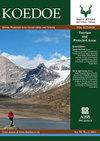Outbreak of avian botulism and its effect on waterbirds in the Wilderness Lakes, South Africa
IF 1.1
4区 环境科学与生态学
Q3 BIODIVERSITY CONSERVATION
引用次数: 4
Abstract
Avian botulism is a non-infectious bird disease resulting from the ingestion of toxins produced by the gram-positive bacterium Clostridium botulinum (Rocke & Friend 1999). Seven different types of botulism neurotoxins occur, labelled A to G (Collins & East 1998), as well as mosaics that have characteristics of two toxins (Rocke & Friend 1999). Avian botulism outbreaks are typically caused by type C (Wobeser 1997), mosaic C/D (Anza et al. 2014) or type E (Getchell & Bowser 2006; Rocke & Friend 1999). Fish die-offs are typically caused by type E (Cromie et al. 2012). Clostridium botulinum is reportedly widespread in wetland sediments where outbreaks are common, and typically requires a source of protein, warm temperatures and low oxygen conditions to activate and produce toxin (Espelund & Klaveness 2014). The salinity and pH of sediments and water may also affect the probability of botulism outbreaks in aquatic ecosystems (Rocke & Friend 1999). The disease in birds is characterised by a flaccid paralysis of the muscles and is invariably fatal (Rocke & Friend 1999). Death typically results from respiratory failure or drowning.禽肉毒杆菌中毒的爆发及其对南非荒野湖区水鸟的影响
禽类肉毒杆菌中毒是一种非传染性禽类疾病,由摄入革兰氏阳性杆菌肉毒梭菌产生的毒素引起(Rocke & Friend 1999)。发生七种不同类型的肉毒中毒神经毒素,标记为A到G (Collins & East 1998),以及具有两种毒素特征的马赛克(Rocke & Friend 1999)。禽肉毒中毒暴发通常由C型(Wobeser 1997)、花叶病C/D型(Anza et al. 2014)或E型(Getchell & Bowser 2006;rock & Friend 1999)。鱼类死亡通常是由E型引起的(Cromie et al. 2012)。据报道,肉毒杆菌广泛存在于经常爆发疫情的湿地沉积物中,通常需要蛋白质来源、温暖的温度和低氧条件来激活和产生毒素(Espelund & Klaveness 2014)。沉积物和水的盐度和pH值也可能影响水生生态系统中肉毒中毒爆发的可能性(Rocke & Friend 1999)。这种疾病在禽类中的特点是肌肉弛缓性麻痹,并且总是致命的(Rocke & Friend 1999)。死亡通常是由于呼吸衰竭或溺水。
本文章由计算机程序翻译,如有差异,请以英文原文为准。
求助全文
约1分钟内获得全文
求助全文
来源期刊

Koedoe
BIODIVERSITY CONSERVATION-
CiteScore
3.30
自引率
0.00%
发文量
10
审稿时长
20 weeks
期刊介绍:
Koedoe, with the subtitle ''African Protected Area Conservation and Science'', promotes and contributes to the scientific (biological) and environmental (ecological and biodiversity) conservation practices of Africa by defining the key disciplines that will ensure the existence of a wide variety of plant and animal species in their natural environments (biological diversity) in Africa.
 求助内容:
求助内容: 应助结果提醒方式:
应助结果提醒方式:


